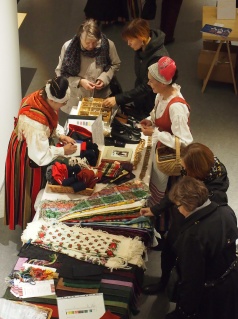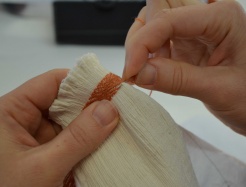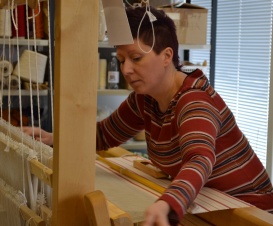Making national costumes
| Making national costumes | ||||
|---|---|---|---|---|
| In the national inventory | ||||
|
Practitioners and people who know the tradition well
National costumes are revised versions of the festive costumes that people wore in the 18th and 19th centuries. The costumes are versions of the festive costumes of the common folk, i.e. the peasants, of the era. The National Costume Center of Finland, located in Jyväskylä, manages matters related to the folk and national costumes of the Finnish speaking areas of Finland. This region also covers the municipalities given over to Russia in the Karelia region. An important part of their duties is to keep the costume traditions alive and share information and the skills of the field. Brage costume office (Brages dräktbyrå) in Helsinki is the body that manages national costume matters of the Swedish-speaking areas of our country.
Men and women of all ages make and wear the costumes, among them both professionals in the field and hobbyists who are interested in handicrafts and making the costumes. Making national costumes requires learning a variety of handicraft skills. There are some individual professionals who have specialised in making national costumes, weaving the fabrics, putting together parts of the costumes or making the jewellery. The regional Taito associations also have their own sector for manufacturing and distributing the national costumes. Suomen Perinnetekstiilit Oy continues the operations of Helmi Vuorelma Oy by manufacturing national costumes and selling the supplies for making them. Brage manufactures the national costumes of the Swedish speaking areas and sells many kinds of national costume supplies from weaving yarns to socks and shoes. Community colleges and adult education centres, as well as regional Taito associations, hold courses for making national costumes. Several folk dance clubs and associations have their own costume collections that loan costumes to their members and rent them to others. They also organise costume making courses for their members. The costume makers and course teachers play a vital role in passing on and continuing the costume making tradition.

Practising of the tradition
Making the Finnish national costumes gives visibility to the festive costume tradition of the common folk in the 18th and 19th centuries. At the time the folk costumes were used, the costumes were made by hand from natural materials. The new, inspected costume designs approved by a national costume jury, made up of experts of the field, are designed as diligently as possible in accordance with their models, the original costume pieces, with regard to both materials and patterns as well as sewing structures.
Making a costume includes many kinds of working methods, such as weaving the fabrics, making gatherings and lace, and making headpieces. Many of the working methods are no longer in use when making modern clothing, such as gatherings, sewing a thick frieze cloth, sewing chamois and making the paper lining of the traditional bonnet worn by women. These skills would have disappeared without the national costume tradition.
The patterns of the clothes are also significantly different to those of modern clothing. The measurements of the costumes as well as their looseness and fit vary from those of 21st century clothes. The shape of folk clothing is achieved through different cuts, folds and pleats.
Today, the model costumes of new and inspected national costume models, approved by the national costume jury, are fully hand-made, as careful replicas of the original costumes as possible. Previously, people wanted to make the costume materials lighter and, at the same time, the sewing structures and patterns have become more industrialised. The materials used in the original folk costumes also enable use of the original sewing structures. The materials and work methods support each other. If the materials are changed, plenty of other things need to be also changed, which makes the costume version too different from the original.
In addition to work methods of the national costume tradition, another interesting aspect is what the costume says about its own era, the time of folk costumes. A national costume is not just a costume or a process of making a costume, but the maker will also have to learn how to put the dress on and wear it, which parts must be included in the costume and why are they used. There is a whole glossary of national costume terms. The names of various materials and costume pieces will become familiar during the process, such as parkkumi (special striped fabric), kamlotti (thin wool fabric), sarka and verka (frieze and baize), röijy (jacket), kostuli (a white piece of cloth with an open neckline worn over a shirt), rekkopaita (shirt with plenty of embroidery), hartuushame (a skirt with shoulder straps), tykkimyssy (a women’s bonnet), etc.

The background and history of the tradition
The history of the Finnish national costumes reaches back a little over 130 years. General interest in a traditional way of life and recording it emerged during national romanticism and the attempts to gain autonomy. At this point, wearing clothes that were in fashion had replaced the festive costumes previously worn by the common folk. University students’ clubs organised trips for collecting folklore, the purpose of which was to gather items and textiles of the common people. As a result of these trips, Ylioppilasosakuntien Kansatieteelliset kokoelmat (the Ethnographical Collections of the Student Clubs) were born. Later on, they became a part of the collections of the National Museum of Finland. The interest in folksy handicrafts resulted in making reproductions of folk costumes, i.e. national costumes. In accordance with the European and Nordic example, the wish was to bring national costume models back into public use.
5 August 1885 is considered the day when the national costumes were first publicly displayed. At the time, Alexander III of Russia, the Russian Emperor, was making an official visit to Finland with his spouse. In Lappeenranta, the Empress was gifted a rowing boat, which was rowed by young women in national costumes.
The first national costume models were collected by Theodor Schvindt, the curator of the State’s historic and ethnographic museum. These models were published in 1898 as a supplement to Koti- ja yhteiskunta (Home and society) magazine. After him, Professor U. T. Sirelius published more national costume models. The officials of the National Museum of Finland have collected numerous national costume models and have dedicated their expertise to the subject. In 1979, however, this duty was adopted by the freshly founded Finnish National Costume Council, which was in operation until 2010. Today, over 400 national costume models have been collected, little less than a half of them from the Swedish-speaking areas of Finland.
During the term of the National Costume Council, the criteria for collecting and making national costumes became clearer. A national costume jury was established and, under the leadership of its costume experts, basic research into national costumes was launched. This resulted in instructions about the traditional process of making national costumes and their different parts. These instructions explained, for example, the special characteristics of a folk costume shirt and shared general guidelines on how to make a shirt for a national costume. Before this, only very limited instructions and patterns for making the costumes were available, which meant that the costumes of the time were not very exact replicas of their original models.
The transmission of the tradition
Today, the body that manages the collection of national costume models and the inspections of the existing costume models is the National Costume Center of Finland. Its key assignments are the promotion of national costume traditions as well as the communication, research, preservation, education and advisory work related to the subject. The expert body of the tradition is the national costume jury that features a comprehensive selection different experts in the field. The National Costume Center of Finland is a part of the Craft Museum of Finland. Brage costume office is in charge of the costume traditions of the Swedish-speaking parts of Finland.
Interest in handicrafts is on the rise again. Many who are considering acquiring a national costume wish to make it themselves. It is seen as an interesting challenge and learning new crafting skills brings pleasure in a modern world otherwise filled by digital things. The completed costume is the primary objective, but the making process in itself is significant. During the process, the maker learns about the traditional costume making as well as the lifestyles of the past, self-sufficiency, a way of life in which nearly all necessary things were made at home by hand. Doing handicrafts was self-evident and they were a part of every woman’s basic skill set. Handicraft skills are not often learned at home anymore with the ‘from the mother to the daughter’ principle. The national costume courses play an important role in the making of the national costumes. The course teachers, in particular, have a key position in passing on information about the costumes and the skills required to make them to the costume users. On the courses, participants can learn about the patterns and fittings of the costumes from a dedicated teacher and learn about the techniques of making them. The courses focus on wearing and using the costumes as well as their history and tradition. The National Costume Center of Finland, on the other hand, trains the makers of national costumes and the course teachers.

The future of the tradition
National costumes and making them still interest people today. Basic education for making national costumes provided by the National Costume Center of Finland and Brage for costume makers and course teachers has gathered a group of enthusiastic students eager to complement their existing knowledge and acquire information about national costumes and skills to make them.
Literature and the internet also offer information about folk and national costumes. The costume-specific instructions of national costume models, especially those approved by the national costume jury, provide information about the materials used for the costumes, detailed instructions for making the costumes and the weaving instructions for the fabrics to be weaved by hand. These can be acquired from the companies distributing the costumes. The method of looking for information has changed as social media has emerged. The websites of Brage and the National Costume Center of Finland have plenty of information on the costumes and on how to use and care for them. The internet pages of professionals in the field also have a lot of national costume information to offer. There is a group for national costume hobbyists on Facebook (kansallispuku), which has several thousand members. They share their experiences of many issues related to national costumes. This group is also a great way for quick communication, such as informing people of various events in the field.
Today, young people may receive national costumes from their relatives as an inheritance. At this point, they will usually become interested in the costume and its history. They want to find out more about the national costume and its traditions. Maybe they need to add some missing parts to the costume or adjust its size for a better fit. In these kinds of situations, the national costume courses are a great help. The national costumes are ensembles that include the costume parts determined in its general design. Using individual parts of the costumes and making them a part of modern clothing styles has become quite a phenomenon in its own right. The beautiful patterns and colours of the traditional flammu-skirt, which is made using carefully died yarns that form a pattern, can be seen in a whole new light when paired with a simple shirt. The pendants made of silver plates make any modern dresses and gowns stand out.
Using the patterns of folk and national costumes with clothes made of modern fabrics creates interesting, new kinds of costume culture. Similar to this, using various folksy decoration styles, such as ribbons and braids, and their methods and utilising them as ideas for creating something new offers plenty of opportunities to designers. Young people, in particular, have shown a completely new kind of interest in the costume tradition. Often, this also sparks the desire to learn more about our national costume tradition.
The communities behind this submission.
Kalevalaisten Naisten Liitto ry
Experts
Soja Murto-Hartikainen (manufacturer of national costumes), Tiina Lajunen (weaver of national costume fabrics, Lajulan kangastupa), Tuulikki Matikainen (manufacturer of national costumes), Annikka Eilola (lacemaker), Marjo Vainio (manufacturer of national costumes) and Seija Pesonen (manufacturer of national costumes)
Bibliography and links to external sources of information
Online sources
National costumes by provinces and municipalities
Vuorelma - Suomen perinnetekstiilit Oy
Bibliography
Appelgren, Kari; Grönlund, Karin; Häggblom, Margareta; Lönnqvist, Bo; Schulman Maria; Vuori, Gunilla 2008: Finlandssvenska dräktboken. Utgiven av Brages sektion för bygdedräkter. Keuru, Otavas tryckeri.
Holst, Leena 2011: Kansallispuku. Maahenki Oy, Porvoo.
Kaukonen, Toini-Inkeri 1985: Suomalaiset kansanpuvut ja kansallispuvut. WSOY, Porvoo.
Lehtinen, Ildikó; Sihvo, Pirkko 2005: Rahwaan puku. Näkökulmia Suomen kansallismuseon kokoelmiin. 3. uudistettu ja laajennettu painos. Museovirasto.

